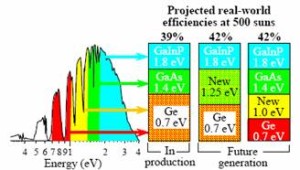
Solar cell efficiency is a race to perform better at converting sunlight to electricity
Solar cell efficiency: If you haven’t already heard, the solar cell efficiency race is on, and once you’ve dusted off your periodic table, it’s a race as scintillating as any big-ticket derby. The stakes, however, are much, much higher as reported by Ceridwen Dovey.
The scientists who are globally acknowledged to be the best at developing solar cells – tweaking them, goading them to perform better at converting sunlight to electricity – have been quietly doing their work for four decades in a laboratory at the University of New South Wales, just up the road from Sydney’s Royal Randwick Racecourse.
It’s here that the man dubbed the “Solar Godfather”, Professor Martin Green, has maintained his research team’s world record in solar cell efficiency (the percentage of sunlight successfully converted into electricity) for 30 of the past 32 years. It’s in large part thanks to these leaps in effectiveness that solar power is predicted to be the cheapest energy on earth within ten years.
In an alternate universe, every Australian would know Green’s name. The reality is that he and his team are fighting to keep their federal government research funding. Speaking at the Paris climate summit last December, Prime Minister Malcolm Turnbull lauded Green’s research, and happily took credit for the work of Australian universities “at the forefront of energy and climate science innovation”. Yet just a few months later, in March, Turnbull announced a plan to gut the early-stage research grants budget of the Australian Renewable Energy Agency’s already small pot of funding, putting at risk most of the projects that Green and his colleagues are running.
Solar cell efficiency – Professor Martin Green
In a conference room at the Australian Centre for Advanced Photovoltaics (ACAP), headquartered at UNSW, Green, the centre’s director and co-founder, hands Ceridwen Dovey a silicon wafer solar cell.
The cell is about the size of a Kindle and is mounted in glass like an awards plaque. Green keeps it on his desk to use as a visual aid when explaining the technology to science dummies like me, though to his credit he doesn’t let on if he thinks my questions are stupid. “See the wafer?” he says. “That’s all silicon. It would have broken by now if it weren’t packaged in glass like this, because it’s quite brittle. But like this it’s very durable.”
This type of silicon wafer cell is the gold standard in the industry, and has already captured more than 90% of the global solar cell market. It has kept Green company for more than 40 years, yet it’s clear he is still fascinated by silicon’s properties. “I think the whole photovoltaic technology itself is a bit magical, you know,” he told ABC TV a few years ago. “Sunlight just falls on this inert material and you get electricity straight out of it.” His working life has been devoted to squeezing more and more power out of each new iteration of the silicon solar cell, gradually adding efficiency percentage points to the previous record.
At the table with us is Chinese-Australian researcher Xiaojing Hao, 38, who is petite, wears her black hair in a bob, and laughs easily and loudly. Hao is a tenured faculty member at the UNSW School of Photovoltaic and Renewable Energy Engineering, and a rapidly rising research star thanks to her work on a different kind of solar cell, CZTS (copper-zinc-tin-sulphide), which has promising applications for building-integrated photovoltaics. She, too, has brought along a specimen to show me: a dark square the size of a Scrabble tile. To read more click here.
Solar cell efficiency will be a discussed at The National Sustainability in Business Conference; renewables, markets, innovation, opportunities and capital will be held 23 – 24 March 2017 at the Hotel Grand Chancellor, Brisbane.
To express your interest in the Conference CLICK HERE.




